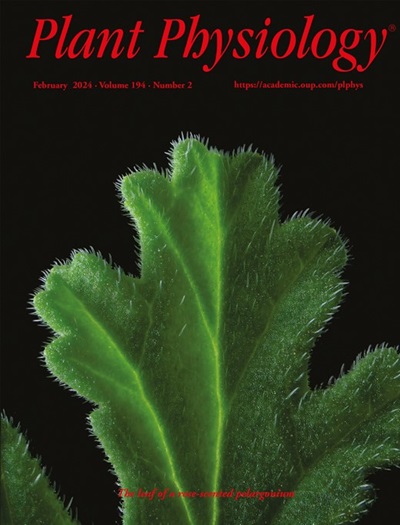细长的下胚轴5和miR156d协调腋生分生组织的成熟和ahl15介导的植物寿命。
IF 6.9
1区 生物学
Q1 PLANT SCIENCES
引用次数: 0
摘要
拟南芥的植物发育受环境因素和内部过程的影响,经历了不同的阶段。细长下胚轴5(细长下胚轴5)是一种重要的光信号转录因子,在植物发育中起着关键作用;但其在开花和营养相变(VPC)中的作用尚不清楚。我们的研究表明,HY5通过结合miR156d启动子中的g -box样基序直接调节microRNA156d (miR156d)的表达。这种相互作用反向调节miR156d和SQUAMOSA启动子结合蛋白样(SPL)基因在野生型和hy5突变株之间的表达。值得注意的是,miR156d过表达(miR156dOX/hy5)的植物表现出开花延迟、营养期延长和寿命延长,这主要是由于腋生分生组织成熟延迟,这与AT-HOOK MOTIF核定位15 (AHL15)水平升高有关,AHL15是SPL基因的靶标。为了研究AHL15的作用,我们在miR156dOX背景下开发了AHL15的敲低系。有趣的是,在hy5植物中,AHL15敲低与miR156dOX结合(AHL15CR/miR156dOX/hy5)表现出超敏反应,比其他基因型更早抽苔。这一发现强调了HY5、miR156d和AHL15之间的调控平衡。总的来说,这种相互作用对于控制植物从营养阶段到生殖阶段的转变和影响植物的寿命至关重要,为植物生活史的分子调控提供了重要的见解。本文章由计算机程序翻译,如有差异,请以英文原文为准。
ELONGATED HYPOCOTYL 5 and miR156d orchestrate axillary meristem maturation and AHL15-mediated plant longevity.
Plant development in Arabidopsis thaliana transitions through various stages influenced by environmental cues and internal processes. ELONGATED HYPOCOTYL 5 (HY5), a critical light-signaling transcription factor, plays a key role in plant development; however, its function in flowering and vegetative phase change (VPC) remains unclear. Our study reveals that HY5 directly regulates the expression of microRNA156d (miR156d) by binding to G-box-like motifs in the miR156d promoter. This interaction inversely modulates the expression of miR156d and SQUAMOSA PROMOTER BINDING PROTEIN-LIKE (SPL) genes between wild-type and hy5 mutant plants. Notably, the miR156d overexpression (miR156dOX/hy5) plants exhibited delayed flowering, extended vegetative phases, and increased longevity, primarily due to a delay in the maturation of the axillary meristem associated with elevated levels of AT-HOOK MOTIF NUCLEAR LOCALIZED 15 (AHL15), a target of SPL genes. To investigate the role of AHL15, we developed knockdown lines for AHL15 in a miR156dOX background. Interestingly, the AHL15 knockdown combined with miR156dOX in hy5 plants (AHL15CR/miR156dOX/hy5) displayed hypersensitivity, bolting substantially earlier than other genotypes. This finding highlights the regulatory balance between HY5, miR156d, and AHL15. Overall, this interplay is crucial for controlling the transition from the vegetative to reproductive stages and influencing plant lifespan, providing essential insights into the molecular regulation of plant life history.
求助全文
通过发布文献求助,成功后即可免费获取论文全文。
去求助
来源期刊

Plant Physiology
生物-植物科学
CiteScore
12.20
自引率
5.40%
发文量
535
审稿时长
2.3 months
期刊介绍:
Plant Physiology® is a distinguished and highly respected journal with a rich history dating back to its establishment in 1926. It stands as a leading international publication in the field of plant biology, covering a comprehensive range of topics from the molecular and structural aspects of plant life to systems biology and ecophysiology. Recognized as the most highly cited journal in plant sciences, Plant Physiology® is a testament to its commitment to excellence and the dissemination of groundbreaking research.
As the official publication of the American Society of Plant Biologists, Plant Physiology® upholds rigorous peer-review standards, ensuring that the scientific community receives the highest quality research. The journal releases 12 issues annually, providing a steady stream of new findings and insights to its readership.
 求助内容:
求助内容: 应助结果提醒方式:
应助结果提醒方式:


